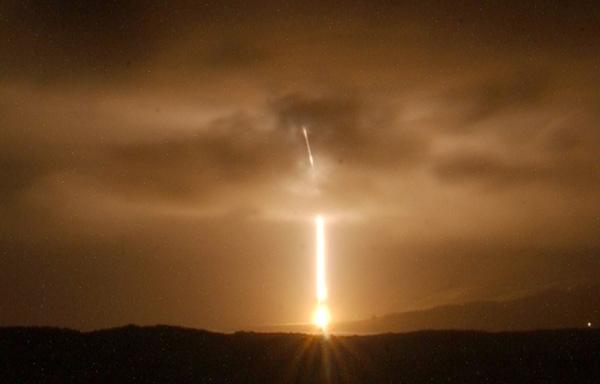The United States said it would bolster defenses against a possible North Korean missile strike a week after Pyongyang threatened a “pre-emptive” nuclear attack against its arch-foe.
Defense Secretary Chuck Hagel said Friday 14 more interceptors would be stationed in Alaska, increasing by almost half the 30 already deployed along the California and Alaska coastlines. The aim is to have them in place by 2017.
North Korea has threatened to unleash a second Korean War — backed by nuclear weapons — in response to UN sanctions imposed after its third atomic test in February and joint South Korea-US military manoeuvres.
As tensions spiral, the North fired short-range missiles into the East Sea (Sea of Japan) Friday, Yonhap news agency said, after leader Kim Jong-Un previously oversaw a live-fire drill near the disputed Yellow Sea border with the South.
Hagel said the defense upgrade was designed to “stay ahead of the threat” from the North Korean regime, which claims to possess missiles capable of carrying a nuclear warhead to the continental United States.
“The United States has missile defense systems in place to protect us from limited ICBM (intercontinental ballistic missile) attacks,” Hagel said.
“But North Korea in particular has recently made advances in its capabilities and is engaged in a series of irresponsible and reckless provocations.”
Apart from mobilizing the additional interceptors at Fort Greely, Alaska, Hagel also confirmed an announcement made last year that the United States plans to deploy a second advanced radar to Japan.
Hagel said the Pentagon was conducting environmental impact studies to clear the way for a possible additional American site for a ground-based missile interceptor, but no location had been chosen.
Tokyo-based international defense analyst Hisao Iwashima said: “The US move may draw another escalation by the North, which may take countermeasures against the latest US move.”
Hideshi Takesada, a Japanese defence expert and former professor at South Korea’s Yonsei University, said the US move showed its “seriousness about its countermeasures against the North’s missile threat.”
He added: “With the planned radar (in Japan), the US early warning system will be complete and can cover the Korean peninsula entirely.”
Baek Seung-Joo of the Korea Institute for Defense Analyses in Seoul told AFP the challenge for South Korea was different due to its proximity to the North.
“It is extremely difficult for South Korea to intercept missiles from the North because its geographical depth is too short. Instead, South Korea is focusing on building up its ability to destroy the North’s missile launching facilities.”
The US missile defense program has been plagued by technical problems but Hagel gave assurances that the “interceptors are effective” and the goal is to deploy the new ones by 2017.
North Korea has missiles that can strike South Korea and Japan but has yet to demonstrate it has the capability to fire long-range missiles that could reach the United States.
Officials worry, however, that the North has made progress on the ICBM front, having put a satellite into orbit, while Pyongyang’s nuclear weapons program heightens concerns about the threat posed by the hermit nation.
The plan to deploy additional interceptors came three days after US national intelligence director James Clapper warned in a congressional hearing for the first time that North Korea’s nuclear weapons and missile programs “pose a serious threat to the United States” as well as its East Asian neighbors.
North Korea confirmed Wednesday it had shredded the 60-year-old armistice ending the 1950-53 Korean War and warned that the next step was an act of “merciless” military retaliation against its enemies.
A lengthy statement by the North’s armed forces ministry added to the tide of dire threats flowing from Pyongyang that have raised military tensions on the Korean peninsula to their highest level for years.
Although the North’s dire threats have been mostly viewed as bluster, the United States and its allies are worried Pyongyang is poised to stage some form of military provocation.
Because the Korean War was concluded with an armistice rather than a peace treaty, the two Koreas have remained technically at war.
The United States retains a major military presence in the region, with naval ships equipped with anti-missile weaponry, 28,000 troops in South Korea and roughly 47,000 on the ground in Japan.










